Shih Tzu Colors
July 8, 2021 2021-07-14 5:41The colorful origins of the diminutive Shih Tzu are reflected in the rainbow colors of its coat. While the leading kennel clubs can be pretty restrictive about the acceptable coat colors of some breeds, when it comes to Shih Tzus, it seems anything goes.
The American Kennel Club (AKC) accepts all different colors and patterns of the Shih Tzu, and its breed standard states, “All are permissible and to be considered equally.”
Both the Fédération Cynologique Internationale (FCI) and the United Kennel Club (UKC) are similarly relaxed about Shih Tzu’s coat colors. The UKC will disqualify albino Shih Tzus, however, and the FCI considers particolored dogs with a “white blaze on the forehead and white tip to tail highly desirable.”
Although the history of this ancient breed can be traced back some 2000 years, the Shih Tzu only started to gain widespread popularity after it was formally recognized by the AKC in 1969. This so-called Lion Dog is now the 20th most popular breed in the US and is widely loved for its happy, affectionate temperament and quirky character.
One of the great things about Shih Tzus is that you’ll hardly ever find two that look the same. The diversity of rich colors, color combinations, and patterns makes this breed the canine equivalent of a box of chocolates.
Although this diversity has its appeal, it also confuses Shih Tzu owners and breeders, especially as the Shih Tzu will often change color over time. Because of this, the AKC allows members to register their Shih Tzus according to skin color rather than the color of their coats, as this will remain constant throughout its life.
There are 19 different colors and color combinations that you can use when registering your Shih Tzu with a kennel club and a further four types of markings or patterns. Let’s start exploring the rainbow world of the Chrysanthemum Dog.
Table of Contents
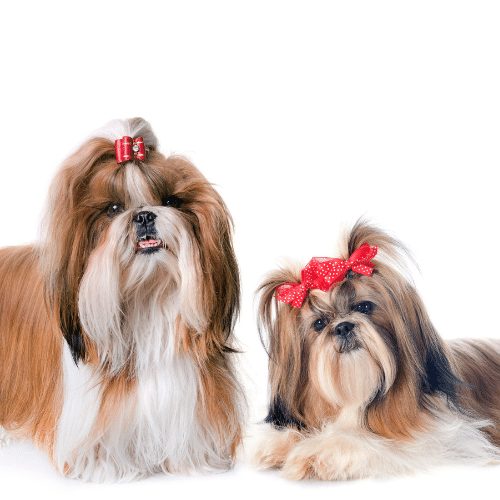
The Nine Solid Colors
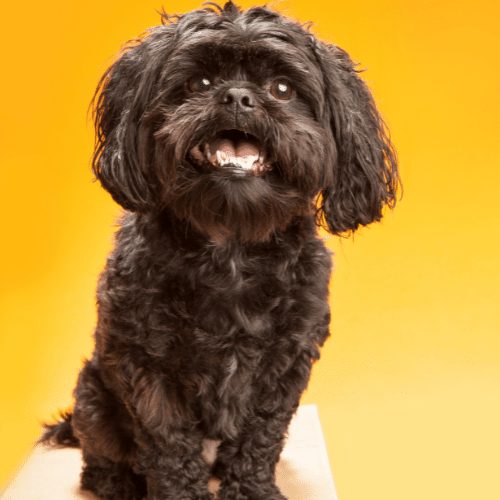
#1 Black
Black isn’t a particularly common color among Shih Tzus, and many of those that appear completely black will have shades of blue or chocolate in their coats. Most black Shih Tzus have white markings somewhere on them, although pure black pups do exist.
Black Shih Tzus with golden hairs visible on its face, paws, or tail is considered to be a black and tan dog rather than a black dog with tan markings.
It seems odd that the pure black Shih Tzu is so rare given that black is a dominant gene in almost all breeds of dogs. In Shih Tzus, however, the dominant black gene in the K locus interacts with the melanocyte-stimulating hormone, MC1R, and the Agouti gene to produce a variety of colors, ranging from pure black to red or gold.
A black Shih Tzu will always have black paws, a black nose, and dark-colored eyes. While its coat may fade to a more silver color as it matures, its black points will remain pure.
Although black Shih Tzus are as healthy as another color, they don’t cope well with hot temperatures. They also are not visible to motorists at night which is why they should be walked in an LED collar or harness.
#2 Blue
A blue Shih Tzu won’t necessarily have a steel grey or blue coat as the term refers to the skin color rather than the color of the coat. Although a blue Shih Tzu may be of such a dark gunmetal gray as to appear black in certain lights, the color of its nose and lips will confirm its true coloration.
Blue Shih Tzus have a lavender cast to their eye rims, nose, and lips which help distinguish them from the black variety, although this is often easier said than done.
The blue coat color is the result of an interaction between the dilution gene, D-Locus allele, and the black allele. Some blue Shih Tzus may also have blue or pale-colored eyes.
Although there is no scientific evidence that blue Shih Tzus are any less healthy than a dog of any other color, some breeders maintain that these dogs are “high risk for defects.”

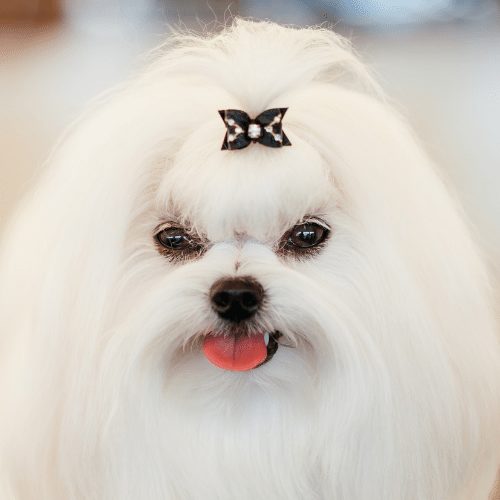
#3 White
White is always a tricky color when it comes to dogs as it’s associated with a lack of pigmentation. It can be easy to confuse a white Shih Tzu with one suffering from albinism and, while white is considered an acceptable color by most kennel clubs, albinism could lead to disqualification.
White is a recessive color so it doesn’t occur as frequently as dominant colors like black or red. White Shih Tzus are the result of an extreme dilution of the red or yellow pigment, pheomelanin, which is caused by the piebald gene. As this gene is recessive, to get a white puppy, both parents must carry the gene but, even then, white offspring are far from guaranteed.
A white dog with a brown nose will be considered liver rather than white, and a true white Shih Tzu should have dark eyes, black eye rims, and a black nose.
Although the pure-white Shih Tzu is one of the most eye-catching, it’s not easy to keep this little guy looking his best. Shih Tzus may have been designed as lap dogs, but that doesn’t mean they don’t enjoy exploring the outdoor world and getting rather grubby in the process.
White Shih Tzu owners must familiarize themselves with the best shampoos for Shih Tzus and commit to a regular and thorough grooming regime if they’re to keep their little lions looking and feeling good.
Many white Shih Tzus are not purebred but have been crossed with the Maltese in an effort to perfect the snowy white appearance.
#4 Gold
A pure gold Shih Tzu is extremely rare even though this color often appears on multi or particolored pooches. A gold Shih Tzu puppy will usually have a vivid coat at birth, but this may fade to a pale yellow as he matures.
Although the gold color is dominant to liver, it’s recessive to black. That means that breeding a black female Shih Tzu to a gold male will, most commonly, produce red puppies with black noses.
Most gold Shih Tzus have a rather more orange or red hue to their coats which makes them look even more like lions than their black and white counterparts.

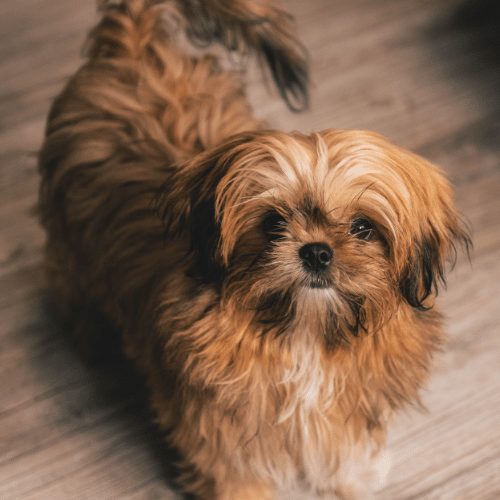
#5 Red
Red Shih Tzus are a similar color to the Irish Setter with their richly colored coats ranging from orange to deep auburn. A red Shih Tzu with a brown nose would be registered as a liver Shih Tzu rather than a red, however, so it’s only those with black noses and deep red coats that can be considered true reds.
Similarly, a red Shih Tzu with white markings is not a true red, while one with a black mask or other black markings is acceptable.
The red coat coloration is produced by one of the most dominant color genes in the Shih Tzu, making it one of the two ‘foundation’ colors of the breed. The same genetic makeup that produces a red puppy can also produce gold, tan, and cream-colored coats, depending on the interaction of other genes.
Some red Shih Tzus are born pure black but reveal their true colors as their adult coats start to become more established.
#6 Liver
In many breeds, liver is considered undesirable because it’s produced by a recessive dilution gene. A liver Cane Corso, for instance, is considered to be a genetic liability while a German Shepherd with a liver-colored coat has, according to the AKC, a “serious fault.”
In the Shih Tzu, however, liver is not only acceptable, but many breeders sell their chocolate-colored puppies for more than they do those of more common colors. One breeder on the AKC Marketplace recently advertised liver Shih Tzu puppies for $3,500 when the average price for a standard-colored pup is between $500 and $1000.
Often referred to as being chocolate-colored, liver Shih Tzus have a uniquely polished look about them which is probably why people find them so appealing.
As with blue, the term liver refers to the color of the dog’s skin rather than its coat, and liver Shih Tzus will always have brown noses. Their lips and the pads on their feet will also normally have a chocolate hue.
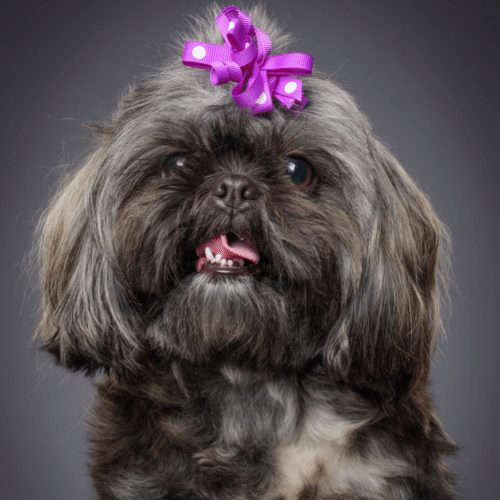
The liver color is produced when the eumelanin or black pigment is diluted by the B locus. As this gene is recessive, a puppy needs to inherit it from both its parents if it’s to turn out truly liver. Having said that, if you breed two black Shih Tzus that both carry the dilution gene, you should get some liver-colored puppies.
Although some experts maintain that, “there are no particular skin or coat conditions that are seen more in liver Shih Tzu than other colors,” others argue that dilute dogs are more susceptible to skin problems and incorrect jaw structures, known as bad bites.
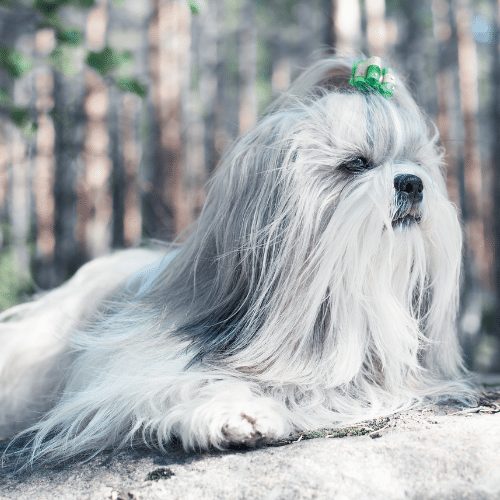
#7 Silver
Listed by the AKC as an acceptable color for Shih Tzus, silver can be difficult to distinguish from white. Silver Shih Tzus are generally pale in appearance but have a silvery sheen to their coats that white Shih Tzus lack. Like the white variety, the silver also has black pads, eye rims, and lips, as well as a black nose.
Age also has a significant impact on a silver dog’s coat coloration, with older silver Shih Tzus becoming increasingly grey as they mature. Conversely, some Shih Tzus that are born black “transition to a more silver color coat” as they age.
Solid silver Shih Tzus are relatively rare even though color combinations like silver and white and black, gold, and silver are comparatively common.
In many breeds, the silver coat color comes from a genetic association with the Weimaraner, but this is unlikely to be the source of the silver Shih Tzu’s coloration.
Although the AKC only lists registration codes for these seven solid colors of Shih Tzu, it’s possible to get lavender or Isabella colored puppies, as well as albino ones, so let’s take a look at how those colors present themselves.
#8 Lavender or Isabella
This unusual shade of dog appears in many different breeds but is most commonly associated with the Weimaraner. The MLPH gene is responsible for the dilution of color that creates this lilac hue. This is the same gene that produces the blue Shih Tzu, the only difference being that in the lavender Shih Tzu it dilutes the brown pigment, whereas, in the blue, it’s the black pigment that’s affected.
Some Isabella Shih Tzus also carry the dilute for liver, which gives them amber or hazel eyes, others may have a lilac tinge to their skins but a particolored coat.
While the AKC recognizes the blue Shih Tzu, it doesn’t include Isabella in its registration codes. That doesn’t stop some breeders from charging more for these unusually colored pups, however, so, if you’re determined to own one, you should look at spending anywhere between $2,200 to $2,700 to secure the puppy of your choice.

#9 Albino
Some breeders maintain that true albino Shih Tzus rarely survive as their genetic makeup weakens their immune system, making it difficult for them to fight off infectious diseases. Despite that, there are plenty of images of albino Shih Tzus that suggest otherwise.
Albinism is a genetic condition that causes a lack of pigmentation in the skin, hair, eyes, and blood vessels. Albino Shih Tzus will invariably have pink skin and blue eyes which while eye-catching, can cause increased sensitivity to light.
What Are The Best Patterns For A Shih Tzu’s Coat?
Not only do Shih Tzus come in a wide variety of different colors, but they can also have a range of patterns and markings. Black and white and red and white are both relatively common in Shih Tzus, but this is only the tip of the iceberg. Shih Tzus can have spots and splashes of color almost anywhere, with some even combining three different colors. Let’s explore some of the most common color combinations and patterns.
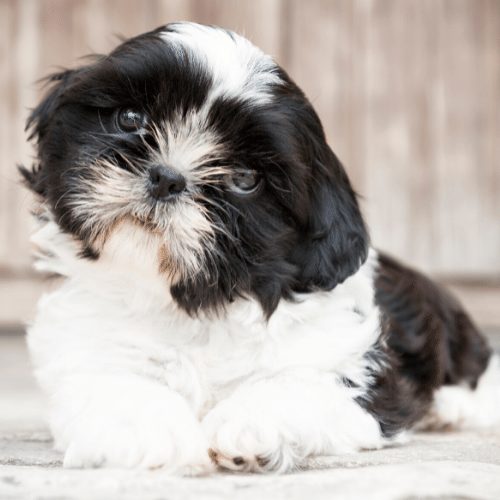
#1 Double Colored Combinations
The AKC lists 7 different double color combinations in its registration codes:
- Black & white
- Red & white
- Blue & white
- Gold & white
- Silver & white
- Brindle & white
- Liver & white
Each of these dogs features its own unique combination of colors and patterns, which often change as the individual matures. A black and white Shih Tzu, for example, could appear increasingly silver and white as he ages, whereas a red and white may transition to gold and white in his later years.
Double-colored Shih Tzus sometimes have markings on top of their two base coat colors. These aren’t the same as the tricolor Shih Tzu, which will have three colors equally represented. A black and white Shih Tzu with red markings, however, may only have a red mask or a small spot of red on its chest.
#2 Tricolor Shih Tzu
You won’t see a lot of tricolor Shih Tzus around, as this color combination is comparatively rare. In many instances, the third color is often faded and difficult to distinguish but, in a few dogs, you can clearly see black, gold, and silver combining to create a luxurious, multicolored coat.
The most common tricolor combination is black and gold with white markings, but even the most experienced Shih Tzu breeder may find it difficult to decide if this constitutes a true tricolor or a double color with white markings.
The most common combination is a black and gold body with white markings mainly around the face. It could also be a mainly gold Shih Tzu with white markings over the chest, and a black face mask would be considered the epitome of tri colored Shih Tzus.
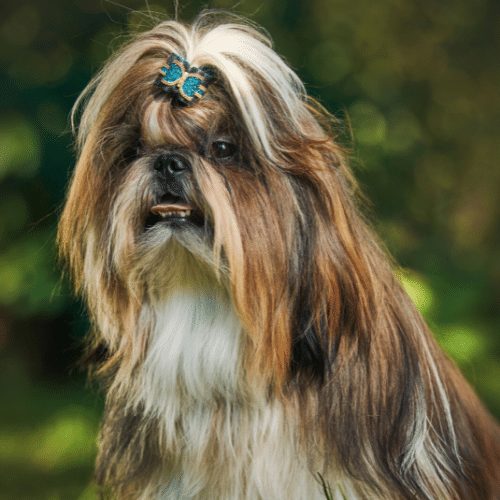
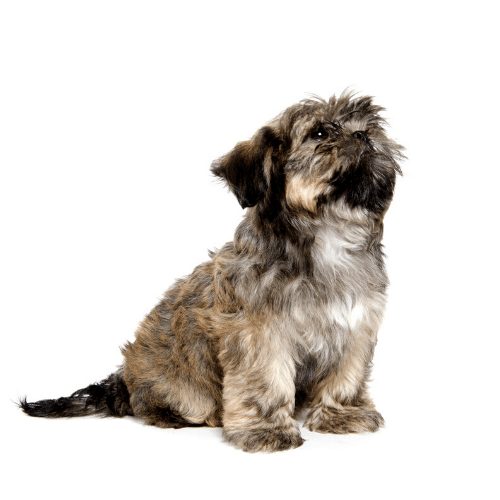
#3 Brindle
Brindle is often described as “tiger-striped” and brindle Shih Tzus have streaks of color running through its base color, creating multi-colored tones ranging from gold or tan to brown or black.
The brindle effect varies widely from dog to dog, and some Shih Tzu puppies born with a distinct brindle pattern may fade as they mature. While some brindle pups will have thick, dark stripes running down their backs, others may have faint, narrow splashes of color, making it difficult for owners to determine whether or not their Shih Tzu’s truly brindle.
Which Shih Tzu Markings Get The Highest Marks?
As we mentioned earlier in our discussion of the double and tricolor coat combinations, Shih Tzus can have a few different markings in addition to their base coat colors and patterns.
A black mask is one of the most common markings, while white markings are more common than tan ones.
In a few instances, you may find a Shih Tzu puppy with tan markings. These are often referred to as ‘Dobie’ dogs because “they resemble the coloration seen on the Doberman Pinscher.” In other words, the dog will be primarily black, with a tan muzzle, tan points above the eyes, and tan-colored paws.
According to the AKC, the following markings are acceptable in the Shih Tzu:
- Black markings
- Black mask
- Tan markings
- White markings
Fascinating Answers To Common Questions About The Shih Tzu
What Is The Most Common Shih Tzu Color?
There seems to be no overriding consensus about which the most common color is for a Shih Tzu. The double-colored coat appears regularly, suggesting that this is more common than a Shih Tzu with a coat of one single solid color.
What is the rarest color in a Shih Tzu?
Although black is one of the most dominant genes, a completely black Shih Tzu, without any white markings, is arguably the least common. Similarly, a pure white Shih Tzu is only seen rarely and a white puppy with black markings is virtually unheard of.
Do Shih Tzus Change Color?
Shih Tzus are born with a coat of soft fluff and only start to lose this so-called puppy coat once they reach six to 12 months of age. As they begin to develop their mature coat so their coloration may change, either darkening or lightening depending on their genetic makeup.
Because Shih Tzus change color as they develop, identifying a Shih Tzus correct color at birth can be extremely challenging, leading to some dogs being misregistered.
Using the wrong shampoos can harm the Shih Tzu’s coat and cause it to lighten or fade. Make sure to only bathe your dog with a shampoo specifically formulated for Shih Tzus.
How Much Does a Shih Tzu Cost?
While you may be able to pick up a Shih Tzu puppy for as little as $250, reputable breeders usually charge between $500 and $1000. Liver puppies are often more expensive and can cost as much as $3,500! Speciality Shih Tzus such as the Teacup Shih Tzu will be even more pricey.
If you’re not too fussy about the color of your Shih Tzu puppy, why not adopt from a rescue center or animal shelter? There are lots of Shih Tzus looking for loving homes, including rare pure black ones. Although you’ll usually have to pay an adoption fee of around $300, this is a cheaper and more ethical way of introducing a little bundle of joy into your life.
Of course, buying a puppy is only the start of your financial investment and a new Shih Tzu owner should budget around $2,500 for the first year of supplies, medical expenses, grooming and haircut costs, license registration, food and training. Each year thereafter your average annual expenditure should drop to around $1,180 per year.

Author: Nicky Hoseck
Nicky lives on a small-holding on South Africa’s Wild Coast with a selection of animals, a husband, and five dogs. She spends all her waking hours with her Australian Cattle Dog, Koala, either walking, horse-riding, running, or just hanging out.
Originally from the UK, Nicky been living with dogs for over 40 years and is a passionate dog-owner.
With a Masters Degree from the University of London under her belt, Nicky has had a diverse career, training and riding horses, running safari lodges, and hosting volunteers. She’s now a full-time writer.

